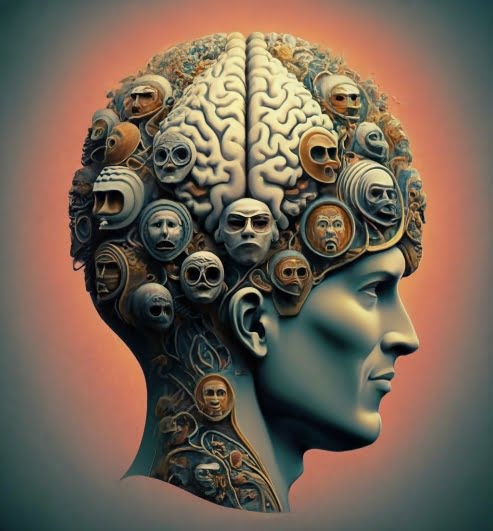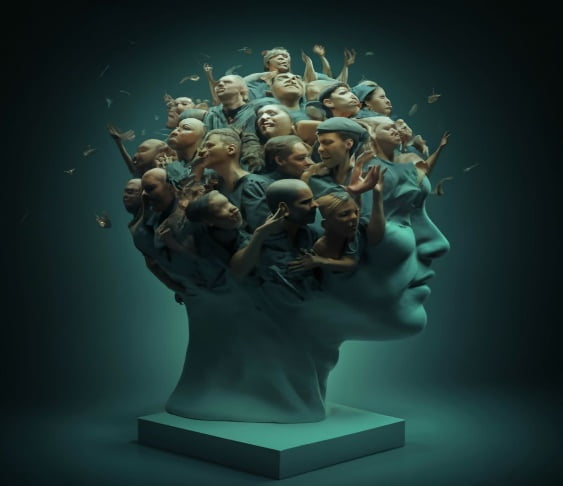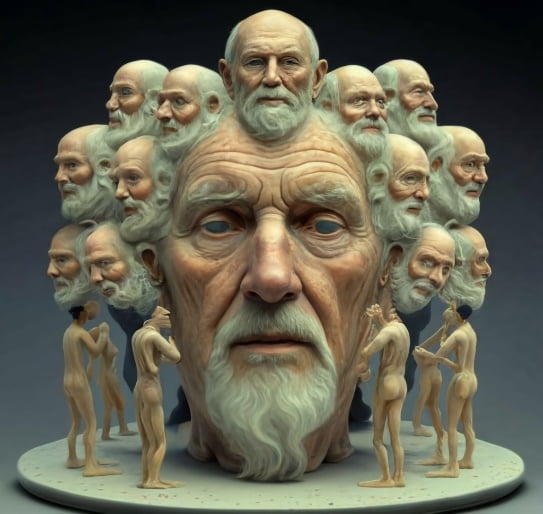Conversation 46: Understanding Obsessive Personality Disorder and Obsessive Compulsive Disorder in light of the model that sees the individual's "social self" as a hierarchical directorate of internalized characters
Greetings to our readers.
First we will again define what internalized figures are: internalized key figures [usually human], usually refer to the significant people in a person's life who have played major roles in shaping the individual's beliefs, values, and self-concept. These figures may include family members, friends, mentors, teachers, or any other influential person who has left a lasting impact on the person's psyche. Sometimes, these will also include historical, literary, and other figures that left a noticeable mark on the person and were internalized by him.
The term "internalized" implies that the influence of these key figures has been absorbed and integrated into the individual's thoughts, attitudes, and behaviors. This internalization occurs through the process of observing, interacting with, and learning from these important people. As a result, the individual may adopt certain values, perspectives, and ways of approaching life that reflect those of the influential figures.

These internalized figures can serve as guiding forces in decision-making, moral thinking and emotional regulation. Positive influences can contribute to a person's well-being, security and resilience, while negative influences can lead to internal conflicts or challenges in personal development.
Recognizing and understanding the influence of internalized human key figures is essential to self-awareness and personal growth. It allows people to evaluate the values they hold, question assumptions and make deliberate decisions about the kind of person they want to be. In addition, the awareness of these internalized influences can contribute to building healthier relationships and fostering positive connections with others.
Below, we will mention again the model we propose for "self":
First, a distinction must be made between the "primary self", which is in fact the basic biological core consisting of a number of innate structures and which is subject to development during life, and the "social self" [consisting of "secondary selves"], which is a structure that develops during the person's exposure to social influence, and consists of the internalization of figures significant to the person, originating from external groups or imaginary groups (related, for example, to a story, myth, movie, etc.) that greatly influenced the person. The "secondary self" included in the "social self" includes:
1] The variety of representations of the "Me" that originate from attitudes and feelings towards the self and its representations in different periods of life
2] Representations of internalized characters that often originate from significant characters that the person was exposed to during his life, but as mentioned may also be imaginary characters represented in books, movies, etc. that greatly influenced the person.
3] internalized representations of "subculture" [subculture refers to social influences in the environment [environment] in which the person lives and are not necessarily related to a particular person].

We call the social self metaphorically "the directorate of characters" or more precisely "the directorate of internalized characters", or "the board of characters". We note that, in this internalized board of directors [this reference group], there is usually a hierarchy in which there are more influential and dominant figures that we metaphorically called "the dictator selves” or “the internal dictators" and these set the tone and even censor and determine which contents, positions and behaviors cannot be included in the board of characters . We note that the person as a whole is not usually aware of the influence of the board of internalized characters and recognizes its influence as arising from his own desires and attitudes.
We will also note that, as a general rule, the board of directors is very dynamic and there are constant struggles and power relations between the internalized characters that make it up regarding the positions that will be expressed, with the internal dictator or dictators usually dictating the tone.

"The Directorate of Internalized Characters"
This is how it is possible to internalize various external figures that influence the person, but we emphasize that usually the most important internalization is that of what we called the "dictator-self". Here it is about internalizing a character that has a great influence and shapes the person for good and/or bad, that has a great influence on the board of internal characters that build the social "self". To this internal dictator we assume a decisive role and a profound influence on the internalization of external figures [or in professional parlance external objects]. The dictator's positions play a central role in making decisions about character internalizations.
He decides whether the internalization should be rejected or, if accepted, in what form it will be internalized. In other words, in a certain sense, we assume that this influential figure is also a kind of internal censor. It should be emphasized that we are not concretely talking or speculating about the presence of internalized characters in the inner world of the individual as a kind of “little people within the brain” but rather in their representations in different brain areas whose nature and manner of representation in the brain still requires further research. We will also note that although we call this figure a "dictator", except for a certain type, his characteristics are not the same as that of a dictatorial ruler of a certain country, but rather that this figure is dominant and influential among the "Directorate of Figures".

We note that for this model a treatment method known as "Reference Group Focused Therapy" or RGFT was developed where the reference groups are usually the board of internalized characters and groups of people in the external reality that influence the individual in different ways.
Below we will define the terms "Trigger Event Analysis" (TEA) and "Sensitivity Channels":
TEA is an analysis of the type of events that may negatively affect a person. Trigger event analysis divides all triggers leading to negative mental impact into 6 categories called "sensitivity channels" of the individual.
These are related to:
1] Status,
2] Norms,
3] Attachment
4] Threat,
5] Routine
6] Energy
These triggers have explicit or implicit social characteristics, i.e. they are related to the reference groups of the patients (directory of the internalized figures and the groups of figures in the external reality).
As a rule, these are negative triggers, or in other words, events that accelerate deterioration or distress in the mental state.
A negative trigger is defined as an event that precipitates mental deterioration that stands with the deterioration in a causal relationship and with which the deterioration appears in a temporal context.
As mentioned, we classify such triggers as belonging to one of the following types:
Status within the reference group:
Examples of such a trigger could be changes in work status, deterioration in marital relations, a significant lottery win, and more.
Conflict with norms associated with the reference group:
Examples of such a trigger could be: pressure from the reference group on the person to perform an action that is inconsistent with the person's moral norms, inability to obey the norms of the reference group (for example due to the person's intellectual ability), unwillingness to accept the norms of the reference group, consequences of violating reference group norms (resulting in some punitive response from the reference group).
Change (or threat of change) in the system of communication with figures significant to a person:
Death of a significant other, severance of relations with a lover, interference with physical contact with a significant other (following recruitment to the army, entering a boarding school, etc.). On the other hand, there are events such as the birth of children, marriage, entry into a new reference group (for a new job, starting studies), etc. Such a change also includes a change in the system of personal relationships to a pet (e.g. a beloved dog) or an object of great value to a person.
Threat to human survival (physical or economic):
Financial problems, serious life-threatening illnesses, etc. belong to this category.
A significant change in lifestyle:
Here we can mention examples such as moving to a new place, vacation, change in work routine, change of role (becoming a parent, retirement, enlistment in the army and more).
Deterioration of human energy resources:
As a result of: overwork, sleep deprivation, unbalanced meals or undereating, related diseases and more.
As a general rule "trigger event analysis" helps us identify the patient's core issues that need to be addressed. The triggers are compared against the relevant reference groups. If triggers are associated with a limited number of specific external reference groups, it is likely that the problem will be related to those external groups – here it is recommended to use the "reference group focused therapy" method for external groups (which will be called "RGFT for external reference groups"). If the triggers refer to an internal reference group – the problem is probably with the patient himself. In this case, the "reference group focused therapy for internalized groups" (RGFT the internal reference group) is recommended.

We will now discuss obsessive personality and obsessive compulsive disorder and reveal the similarities and differences between them.
While the two conditions, obsessive-compulsive personality (OP) and obsessive-compulsive disorder (OCD), share the common thread of obsession, their unique characteristics, etiology, and treatment approaches differentiate them.
Below are the diagnostic criteria for each of the conditions:
Obsessive Personality (OP):
Obsessive personality disorder is not officially recognized as a distinct psychiatric disorder in major diagnostic books such as the DSM-5. However, it is commonly associated with personality disorders, particularly obsessive-compulsive personality disorder (OCPD). These people exhibit perfectionism, preoccupation with details and a need for control, often at the expense of interpersonal relationships.
Obsessive-compulsive disorder (OCD):
OCD is a well-established psychiatric disorder defined by the DSM-5. It is characterized by the presence of obsessions (intrusive, disturbing thoughts) and compulsions (compulsive ritualistic behaviors aimed at relieving anxiety or preventing a feared event). OCD significantly impairs daily functioning and quality of life.
Etiology:
Obsessive Personality (OP):
It is believed that the development of an obsessive personality involves a combination of genetic, environmental and personal factors. This personality is often associated with a rigid upbringing, high parental expectations, a tendency to anxiety.
Obsessive-compulsive disorder (OCD):
OCD has a complex etiology involving genetic, neurobiological and environmental factors. Dysregulation of serotonin and other neurotransmitters, childhood trauma, infections, and stressful life events may contribute to the onset of OCD.
Neurobiological correlation:
Brain imaging studies indicate that both OP and OCD involve changes in brain structures and functions, particularly in areas associated with cognitive control, such as the orbitofrontal cortex and frontal gyrus. However, the specific patterns and severity of these changes differ between the two.
Therapeutic approaches:
Obsessive Personality (OP):
The accepted treatment for OP mainly includes psychotherapy, focusing on treating maladaptive personality traits and improving interpersonal functioning. Cognitive behavioral therapy (CBT) may be helpful in challenging perfectionistic tendencies and fostering flexibility.
Obsessive-compulsive disorder (OCD):
OCD is often treated with a combination of psychotherapy, especially exposure and response prevention (ERP), and medication, usually selective serotonin reuptake inhibitors (SSRIs). Exposure and response prevention ERP aims to reduce compulsive behaviors through controlled exposure to anxiety-provoking stimuli.
Conclusion:
In conclusion, while obsessive personality and obsessive-compulsive disorder share common features related to obsessions, they differ significantly in terms of diagnostic criteria, etiology, and treatment approaches. Recognizing these distinctions is essential for accurate diagnosis and effective intervention. More research is needed to improve our understanding of these disorders and refine treatment strategies to improve outcomes.
We propose that the individual's social self consists of internalized key figures that have influenced the individual. How can obsessive personality and obsessive-compulsive disorder be explained against the background of this concept?
The concept that the individual's social self consists of internalized key figures that have influenced him is consistent with psychodynamic and developmental perspectives. When considering obsessive personality (OP) and obsessive-compulsive disorder (OCD) using this framework, it provides insights into how internalized characters may contribute to the development and expression of these disorders.
Internalized Key Characters involved in obsessive personality (OP):
First, people with obsessive personalities may internalize significant authority figures or role models who emphasize perfectionism, control, and rigid adherence to rules. These internalized figures shape the individual's self-perception, and influence his beliefs about what is expected of him.
Second, the internalization of demanding or critical figures can contribute to the development of obsessive personality traits, such as perfectionism and an excessive focus on details. The individual may always strive to meet unrealistically high standards, driven by the internalized expectations of these influential figures.
Internalized Key Characters in Obsessive-Compulsive Disorder (OCD):
First, in the case of obsessive-compulsive disorder, the internalization process may include a combination of figures related to fear or injury following traumatic experiences or a combination of authoritative figures warning of potential dangers, which leads to the development of obsessive thoughts related to injury or contamination.
Second, compulsive behaviors in OCD can appear as a way to gain control over the anxiety associated with these internalized threats. The repetitive rituals and actions may be irrational attempts to defend against the expectations or perceived warnings of these influential internalized figures.
Impact on identity and interpersonal dynamics:
Internalized key figures contribute to the construction of the individual's self-identity. In both disorders the social self may be deeply intertwined with the characteristics and expectations of these internalized characters.
Also, interpersonal relationships may be affected, as people with obsessive traits may have difficulty in areas that require flexibility and compromise due to the rigid standards set by their internalized figures. In obsessive-compulsive disorder, the fear of external judgment on the behavior or fear and anxiety of harm may motivate avoidance behaviors, and affect social interactions.
Therapeutic implications:
It is accepted that psychodynamic and insight-oriented therapies may be valuable in dealing with obsessive personality traits or compulsive behaviors by exploring the origins of intrernalized characters and challenging maladaptive beliefs.
We believe that recognition and understanding of the influence of these internalized characters can guide therapeutic interventions in the therapeutic method focused on the reference group aimed at promoting more adaptive coping mechanisms.
In conclusion, internalized key figures play a significant role in shaping self-concept and influencing behaviors in people with obsessive personality and obsessive-compulsive disorder. Investigating the influence of these internalized figures provides a nuanced understanding of the origins of obsessive traits and behaviors, and paves the way for targeted therapeutic interventions.
We believe that a good understanding of the disorders combines both the directorate of internalized characters on the one hand and the individual's channels of sensitivity. Usually the obsessive personality is particularly sensitive to changes in routine and to triggers that undermine the characteristics of routine. In obsessive-compulsive disorder, there is great sensitivity to the threat channel and apparently also to the routine channel, so that triggers that undermine these will lead to an exacerbation or awakening of the disorder.
It often seems that in obsessive personality disorder there may be a dominant figure of an internal dictator with rigid and inflexible obsessive characteristics sensitive to changes in routine who censors inappropriate content, while in obsessive-compulsive disorder there is such an influential figure sensitive to threat and changes in routine.
In therapy, it is possible to gradually create a modulating and softening internalized character of the therapist or to give more space and dominance to an existing character in the patient's board of directors who will regulate or moderate the internal dictator or to create with the patient a character that sees alternatives and is more flexible in its perception and behavior.
It is also possible to raise the dominant figure to the hot chair [here, under the direction of the therapist, the patient speaks in the chair designated for this as the dominant figure, as if he is him with all the perceptions and attitudes] and disclose to the dominant inner figure, while giving all due respect to it, that sometimes its way does not achieve the desired results, and if it wants the patient's best interest, perhaps it is worthwhile to moderate its positions or take into account other positions as well.
Case report: G.S. Obsessive personality:
Patient G.S., a 45-year-old man, exhibits traits consistent with an obsessive personality. Through Reference Group Focused Therapy [RGFT] it is revealed that his key internalized figure is his father, a parent who emphasized perfectionism and control in his formative years. The patient internalized these expectations, leading to strict adherence to rules and a strong need for order. The treatment focuses on challenging maladaptive beliefs and cultivating flexibility in thinking and behavior.
Case report: A.P. Obsessive personality:


An accountant who testifies that he was "messy" in adolescence, did not keep time, did not follow norms and rules of routine. One day when these actions reached an excessive level in the eyes of his father who had an obsessive personality, this angry father took him to his beautifully arranged work desk, opened all his drawers where everything was perfectly arranged like soldiers in order and shouted only two words: "Like this".
A.P. was at moment in experience of a terrible fear of abandonment and from that day he became obsessed with order. Apparently the father sent a powerful visual and threatening message. We note that it was a very dominant father in the family who was internalized by him as an internal dictator in the board of directors of his internalized figures.
Case Report: TM Obsessive-Compulsive Disorder (OCD):
The patient T.M. A 28-year-old plumber presents symptoms of obsessive-compulsive disorder. Through the treatment it becomes clear that the key internalized figure is that of his mother who instilled in him a deep fear of harm and a need for excessive cleaning. The patient's obsessions revolve around fears of contamination, and compulsions or rituals involving frequent hand washing. We note that there was a very dominant mother type in the family who was internalized by him as an internal dictator in the board of his internalized figures.

Case report: D.K., interaction between obsessive personality and obsessive-compulsive disorder:
D.K. patient , a 43-year-old man, demonstrates a complex interaction between obsessive personality and obsessive-compulsive disorder. The intrernalized key figure is a strict authoritarian father figure who emphasizes both perfectionism and cleanliness. The patient struggles with the relentless pursuit of perfection in work tasks (obsessive personality) while also experiencing disturbing obsessions related to fears of contamination (and obsessive-compulsive disorder).
We note that it was a very dominant father in the family who was internalized by him as an internal dictator in the board of directors of his internalized figures.

These cases illustrate the potential influence of internalized key figures on the development and expression of obsessive personality and obsessive-compulsive disorder. It emphasizes the importance of understanding an individual's early experiences and interpersonal relationships in tailoring effective therapeutic interventions.
That's it for now,
Dr. Igor Salganik and Prof. Joseph Levine
 Prof. Joseph Levine, M.D. is an emeritus associate professor in the Division of Psychiatry, Faculty of Health Sciences, Ben Gurion University in Israel. Prof. Levine is a certified psychiatrist with clinical experience in controlled trials of adult psychiatric disorders and in psychotherapy. He was awarded a NRSAD independent investigator grant for the study of Creatine Monohydrate in psychiatric disorders -- mainly Schizophrenia. He resides and treats patients in Tel Aviv and all of central Israel.
Prof. Joseph Levine, M.D. is an emeritus associate professor in the Division of Psychiatry, Faculty of Health Sciences, Ben Gurion University in Israel. Prof. Levine is a certified psychiatrist with clinical experience in controlled trials of adult psychiatric disorders and in psychotherapy. He was awarded a NRSAD independent investigator grant for the study of Creatine Monohydrate in psychiatric disorders -- mainly Schizophrenia. He resides and treats patients in Tel Aviv and all of central Israel.
Leave a comment